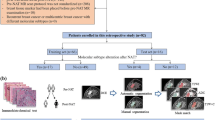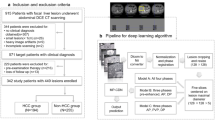Abstract
Objectives
To compare the overall image quality and detectability of significant (malignant and pre-malignant) liver lesions of low-dose liver CT (LDCT, 33.3% dose) using deep learning denoising (DLD) to standard-dose CT (SDCT, 100% dose) using model-based iterative reconstruction (MBIR).
Methods
In this retrospective study, CT images of 80 patients with hepatic focal lesions were included. For noninferiority analysis of overall image quality, a margin of − 0.5 points (scored in a 5-point scale) for the difference between scan protocols was pre-defined. Other quantitative or qualitative image quality assessments were performed. Additionally, detectability of significant liver lesions was compared, with 64 pairs of CT, using the jackknife alternative free-response ROC analysis, with noninferior margin defined by the lower limit of 95% confidence interval (CI) of the difference of figure-of-merit less than − 0.1.
Results
The mean overall image quality scores with LDCT and SDCT were 3.77 ± 0.38 and 3.94 ± 0.34, respectively, demonstrating a difference of − 0.17 (95% CI: − 0.21 to − 0.12), which did not cross the predefined noninferiority margin of − 0.5. Furthermore, LDCT showed significantly superior quantitative results of liver lesion contrast to noise ratio (p < 0.05). However, although LDCT scored higher than the average score in qualitative image quality assessments, they were significantly lower than those of SDCT (p < 0.05). Figure-of-merit for lesion detection was 0.859 for LDCT and 0.878 for SDCT, showing noninferiority (difference: − 0.019, 95% CI: − 0.058 to 0.021).
Conclusion
LDCT using DLD with 67% radiation dose reduction showed non-inferior overall image quality and lesion detectability, compared to SDCT.
Key Points
• Low-dose liver CT using deep learning denoising (DLD), at 67% dose reduction, provided non-inferior overall image quality compared to standard-dose CT using model-based iterative reconstruction (MBIR).
• Low-dose CT using DLD showed significantly less noise and higher CNR lesion to liver than standard-dose CT using MBIR and demonstrated at least average image quality score among all readers, albeit with lower scores than standard-dose CT using MBIR.
• Low-dose liver CT showed noninferior detectability for malignant and pre-malignant liver lesions, compared to standard-dose CT.





Similar content being viewed by others
Abbreviations
- CNR:
-
Contrast‐to‐noise ratio
- CT:
-
Computed tomography
- CTDIvol :
-
Volume computed tomography dose index
- DLD:
-
Deep learning denoising
- DLP:
-
Dose-length product
- FBP:
-
Filtered back projection
- IR:
-
Iterative reconstruction
- LDCT:
-
Low-dose CT
- MBIR:
-
Model-based iterative reconstruction
- NPS:
-
Noise power spectrum
- ROI:
-
Region of interest
- SDCT:
-
Standard-dose CT
- SNR:
-
Signal-to-noise ratio
References
Brenner DJ (2010) Should we be concerned about the rapid increase in CT usage? Rev Environ Health 25:63–68
Pearce MS, Salotti JA, Little MP et al (2012) Radiation exposure from CT scans in childhood and subsequent risk of leukaemia and brain tumours: a retrospective cohort study. Lancet 380:499–505
Mathews JD, Forsythe AV, Brady Z et al (2013) Cancer risk in 680,000 people exposed to computed tomography scans in childhood or adolescence: data linkage study of 11 million Australians. BMJ 346:f2360
Brenner DJ, Hall EJ (2007) Computed tomography–an increasing source of radiation exposure. N Engl J Med 357:2277–2284
Mahesh M (2010) Medical radiation exposure with focus on CT. Rev Environ Health 25:69–74
Chityala R, Hoffmann KR, Bednarek DR, Rudin S (2004) Region of interest (ROI) computed tomography. Proc SPIE Int Soc Opt Eng 5368:534–541
Bubba T, Labate D, Zanghirati G, Bonettini S, Goossens B (2015) Shearlet-based regularized ROI reconstruction in fan beam computed tomography. Proc SPIE 9597. https://doi.org/10.1117/12.2187387
Azencott R, Bodmann BG, Chowdhury T, Labate D, Sen A, Vera D (2015) Region-of-interest reconstruction from truncated cone-beam projections. arXiv preprint arXiv:150201114
Willemink MJ, Noël PB (2019) The evolution of image reconstruction for CT-from filtered back projection to artificial intelligence. Eur Radiol 29:2185–2195
Kataria B, Althén JN, Smedby Ö, Persson A, Sökjer H, Sandborg M (2018) Assessment of image quality in abdominal CT: potential dose reduction with model-based iterative reconstruction. Eur Radiol 28:2464–2473
Brady SL, Yee BS, Kaufman RA (2012) Characterization of adaptive statistical iterative reconstruction algorithm for dose reduction in CT: a pediatric oncology perspective. Med Phys 39:5520–5531
Smith EA, Dillman JR, Goodsitt MM, Christodoulou EG, Keshavarzi N, Strouse PJ (2014) Model-based iterative reconstruction: effect on patient radiation dose and image quality in pediatric body CT. Radiology 270:526–534
Gramer BM, Muenzel D, Leber V et al (2012) Impact of iterative reconstruction on CNR and SNR in dynamic myocardial perfusion imaging in an animal model. Eur Radiol 22:2654–2661
Noël PB, Engels S, Köhler T et al (2018) Evaluation of an iterative model-based CT reconstruction algorithm by intra-patient comparison of standard and ultra-low-dose examinations. Acta Radiol 59:1225–1231
Jensen CT, Liu X, Tamm EP et al (2020) Image quality assessment of abdominal CT by use of new deep learning image reconstruction: initial experience. AJR Am J Roentgenol 215:50–57
Singh R, Digumarthy SR, Muse VV et al (2020) Image quality and lesion detection on deep learning reconstruction and iterative reconstruction of submillisievert chest and abdominal CT. AJR Am J Roentgenol 214:566–573
Wolterink JM, Leiner T, Viergever MA, Isgum I (2017) Generative adversarial networks for noise reduction in low-dose CT. IEEE Trans Med Imaging 36:2536–2545
Chen H, Zhang Y, Kalra MK et al (2017) Low-dose CT with a residual encoder-decoder convolutional neural network. IEEE Trans Med Imaging 36:2524–2535
Akagi M, Nakamura Y, Higaki T et al (2019) Deep learning reconstruction improves image quality of abdominal ultra-high-resolution CT. Eur Radiol 29:6163–6171
Greffier J, Hamard A, Pereira F et al (2020) Image quality and dose reduction opportunity of deep learning image reconstruction algorithm for CT: a phantom study. Eur Radiol 30:3951–3959
Ahn C, Heo C, Kim JH (2019) Combined low-dose simulation and deep learning for CT denoising: application in ultra-low-dose chest CT. Proc SPIE 11050. https://doi.org/10.1117/12.2521539
Wu D, Kim K, El Fakhri G, Li Q (2017) Iterative low-dose CT reconstruction with priors trained by artificial neural network. IEEE Trans Med Imaging 36:2479–2486
Yi X, Babyn P (2018) Sharpness-aware low-dose CT denoising using conditional generative adversarial network. J Digit Imaging 31:655–669
Kang E, Min J, Ye JC (2017) A deep convolutional neural network using directional wavelets for low-dose X-ray CT reconstruction. Med Phys 44:e360–e375
Brady SL, Trout AT, Somasundaram E, Anton CG, Li Y, Dillman JR (2020) Improving image quality and reducing radiation dose for pediatric CT by using deep learning reconstruction. Radiology. https://doi.org/10.1148/radiol.2020202317:202317
Shin YJ, Chang W, Ye JC et al (2020) Low-dose abdominal CT using a deep learning-based denoising algorithm: a comparison with CT reconstructed with filtered back projection or iterative reconstruction algorithm. Korean J Radiol 21:356–364
Solomon J, Lyu P, Marin D, Samei E (2020) Noise and spatial resolution properties of a commercially available deep learning-based CT reconstruction algorithm. Med Phys. https://doi.org/10.1002/mp.14319
Schindera ST, Odedra D, Raza SA et al (2013) Iterative reconstruction algorithm for CT: can radiation dose be decreased while low-contrast detectability is preserved? Radiology 269:511–518
Ellmann S, Kammerer F, Allmendinger T et al (2018) Advanced Modeled Iterative Reconstruction (ADMIRE) facilitates radiation dose reduction in abdominal CT. Acad Radiol 25:1277–1284
Hausleiter J, Martinoff S, Hadamitzky M et al (2010) Image quality and radiation exposure with a low tube voltage protocol for coronary CT angiography results of the PROTECTION II Trial. JACC Cardiovasc Imaging 3:1113–1123
Ahn S, Park SH, Lee KH (2013) How to demonstrate similarity by using noninferiority and equivalence statistical testing in radiology research. Radiology 267:328–338
American Association of Physicists in Medicine (2008) The measurement, reporting, and management of radiation dose in CT. AAPM report. Available via https://www.aapm.org/pubs/reports/RPT_96.pdf
Ahn CK, Jin H, Heo C, Kim JH (2019) Combined low-dose simulation and deep learning for CT denoising: application of ultra-low-dose cardiac CTA. Proc SPIE 10948. https://doi.org/10.1117/12.2513144
Chang W, Lee JM, Lee K et al (2013) Assessment of a model-based, iterative reconstruction algorithm (MBIR) regarding image quality and dose reduction in liver computed tomography. Invest Radiol 48:598–606
Nam JG, Lee JM, Lee SM et al (2019) High Acceleration three-dimensional T1-weighted dual echo dixon hepatobiliary phase imaging using compressed sensing-sensitivity encoding: comparison of image quality and solid lesion detectability with the standard T1-weighted sequence. Korean J Radiol 20:438–448
Fletcher JG, Yu L, Li Z et al (2015) Observer performance in the detection and classification of malignant hepatic nodules and masses with CT image-space denoising and iterative reconstruction. Radiology 276:465–478
Fletcher JG, Fidler JL, Venkatesh SK et al (2018) Observer performance with varying radiation dose and reconstruction methods for detection of hepatic metastases. Radiology 289:455–464
Choi SJ, Park SH, Shim YS et al (2020) Comparison of image quality and focal lesion detection in abdominopelvic CT: potential dose reduction using advanced modelled iterative reconstruction. Clin Imaging 62:41–48
Hong JH, Park EA, Lee W, Ahn C, Kim JH (2020) Incremental image noise reduction in coronary CT angiography using a deep learning-based technique with iterative reconstruction. Korean J Radiol 21:1165–1177
Solomon J, Marin D, Roy Choudhury K, Patel B, Samei E (2017) Effect of radiation dose reduction and reconstruction algorithm on image noise, contrast, resolution, and detectability of subtle hypoattenuating liver lesions at multidetector CT: filtered back projection versus a commercial model-based iterative reconstruction algorithm. Radiology 284:777–787
Jensen CT, Wagner-Bartak NA, Vu LN et al (2019) Detection of colorectal hepatic metastases is superior at standard radiation dose CT versus reduced dose CT. Radiology 290:400–409
Pooler BD, Lubner MG, Kim DH et al (2017) Prospective evaluation of reduced dose computed tomography for the detection of low-contrast liver lesions: direct comparison with concurrent standard dose imaging. Eur Radiol 27:2055–2066
Funding
The authors state that this work has not received any funding.
Author information
Authors and Affiliations
Corresponding author
Ethics declarations
Guarantor
The scientific guarantor of this publication is Jeong Min Lee (J.M.L.).
Conflict of interest
J.M.L. is a consultant to Samsung Medison; institution received grants from Samsung Medison, GE Healthcare, Philips Healthcare, Bayer, Guerbet, Bracco, Central Medical Service, and Canon Healthcare; institution was compensated for lectures by Bayer, Samsung Medison, and Bracco. However, J.M.L. performs no activities related to the present article and disclosed no relevant relationships.
One author (J.H.K.) was a stockholder of ClariPI, but did not have control over any of the data or information submitted for publication.
One author (C.A.) was an employee of ClariPi and performed imaging data processing, but did not have control over any of statistical analysis for publication.
Other authors of this manuscript declare no relationships with any companies, whose products or services may be related to the subject matter of the article.
Statistics and biometry
This study was revised, under the advice of the Konkuk University Medical Center Research Coordinating Center.
Informed consent
Written informed consent was waived by the Institutional Review Board.
Ethical approval
Institutional Review Board approval was obtained.
Methodology
• retrospective
• observational study performed at one institution
Additional information
Publisher’s note
Springer Nature remains neutral with regard to jurisdictional claims in published maps and institutional affiliations.
Supplementary Information
Below is the link to the electronic supplementary material.
Rights and permissions
About this article
Cite this article
Park, S., Yoon, J.H., Joo, I. et al. Image quality in liver CT: low-dose deep learning vs standard-dose model-based iterative reconstructions. Eur Radiol 32, 2865–2874 (2022). https://doi.org/10.1007/s00330-021-08380-0
Received:
Revised:
Accepted:
Published:
Issue Date:
DOI: https://doi.org/10.1007/s00330-021-08380-0




